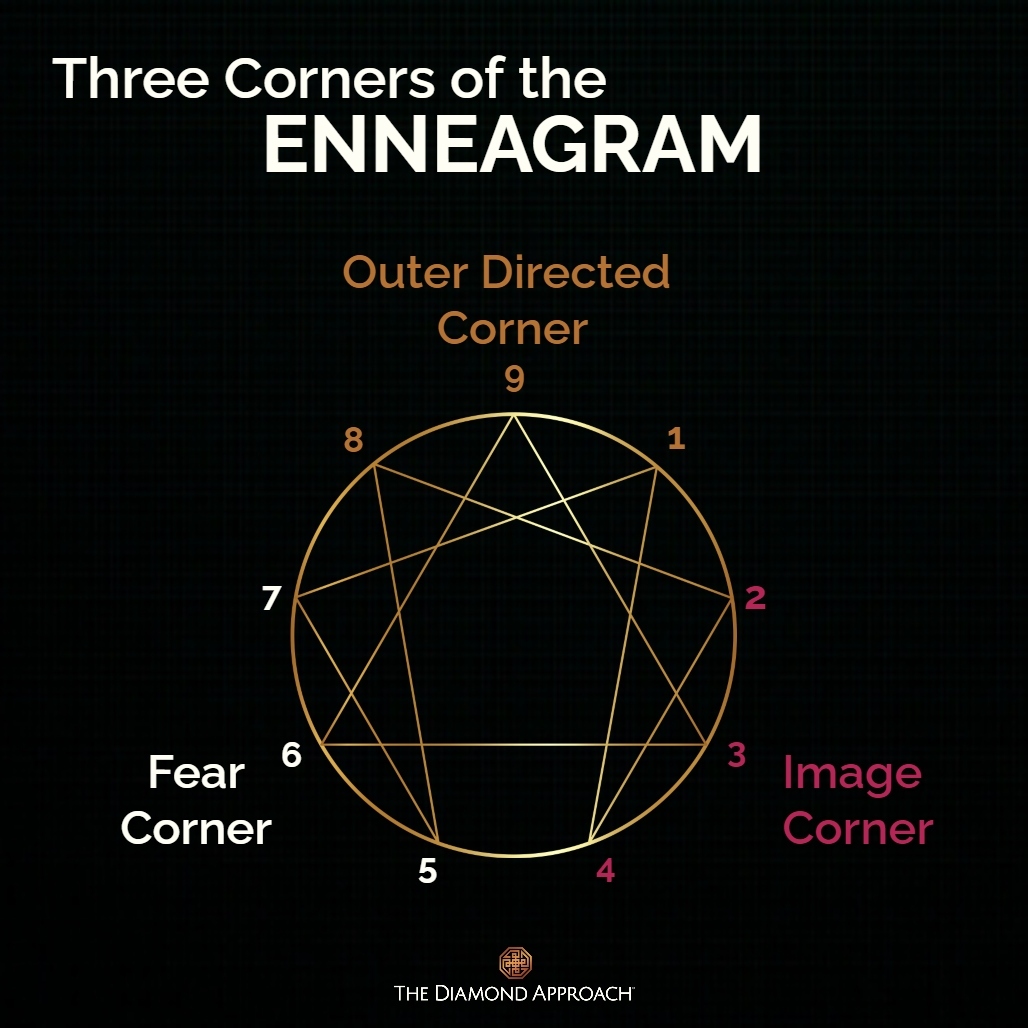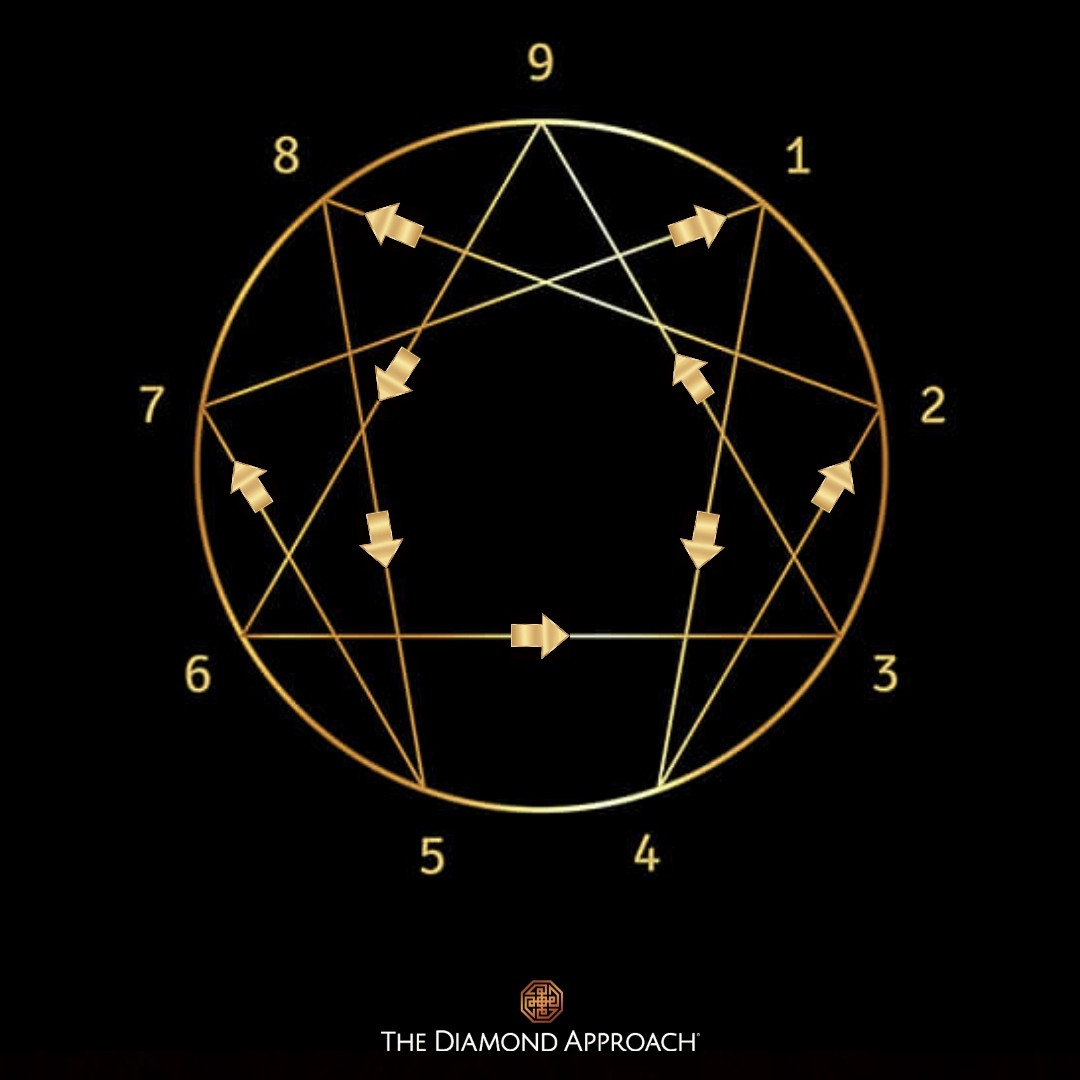The Enneagram is a personality typology system that provides an in-depth understanding of our inner world—our motivations and fears, how we deal with challenges and stress, our preferred social interaction styles, and how we manage our experience in the world. Studying the Enneagram gives us a deeper understanding of ourselves, others, our relationships, and provides insightful wisdom and offers the potential for deeper personal and spiritual growth.
In this site, we will provide a very brief introduction to the Enneagram for people unfamiliar with it. However, our primary intention is to share wisdom and insight into how the Enneagram can be used not just for personal growth and support for our lives, but for spiritual realization--to understand fundamentally who and what we are. This is the purpose for which it was intended.
Nine Types
The Enneagram of Personality describes nine interconnected personality types, also called ennea-types. Each personality type has a distinct set of character traits and patterns that describe its fundamental view of reality, beliefs about oneself, thought processes, emotional patterns, and behaviors. The Enneagram describes the root of its beliefs and attitudes, which then influence what we perceive and experience in our lives.
By studying each of the nine personality types associated with the points on the Enneagram symbol, we gain deep insights into our own personality structure and that of others, which can lead to deeper freedom and connection with our True Nature.
For most of us, our lives are lived within the narrow confines of what we take ourselves and the world around us to be, which, from the perspective of those not so imprisoned, is a tiny part of what is truly available to us.
-Sandra Maitri -
The Wings
Each of us tends to develop a personality or ego structure characterized by one primary ennea-type. Within the Enneagram, each type has two types immediately adjacent to it, called its wings. Each type can be understood as the interaction between its wings. While one wing may be more obvious in a person's behavior than the other, their ennea-type is always the interplay between its wings.
Identifying your Enneatype
There are three primary ways of identifying your ennea-type:
- Self-assess: Read about the nine types and try to self-assess your personality style, based on what feels like the best match. This is a common starting point, but it's difficult to see ourselves objectively, therefore it can be helpful to use external tools.
- Enneagram test: There are many Enneagram tests that take you through a series of questions to help you determine your type. These exist within many of the popular Enneagram books and there are online tests, both free and paid.
- Work with an experienced Enneagram teacher: Working with an Enneagram teacher or coach who is good at typing is the most effective way to determine your type while also deepening your knowledge of the system and how to work with it. A guide will have knowledge of the Enneagram and a more objective view of your personality. They may also provide guidance on how to deal with common issues and leverage strengths related to your type, and how to apply that knowledge for personal and spiritual growth.
The Three Corners of the Enneagram
The nine types of the Enneagram are grouped into three corners. These are the types on the inner triangle of the Enneagram and the points on either side of them. As such, each corner is a grouping of three related types that share similar behavioral styles and have an underlying preoccupation. Developing an understanding of the corners provides an understanding of the central style and preoccupation that the types in that corner share.
- Points 8, 9, and 1 form the Outer Directed Corner. These types orient outward and, in the process, “fall asleep” to their internal experience and needs.
- Points 5, 6, and 7 are in the Fear Corner. Their strongest tendency is to orient around and from fear, which creates self-reinforcing cycles of anxious experience.
- Points 2, 3, and 4 make up the Image Corner. These types are excessively concerned with how they impact others, their external presentation, and their self-image.
Defensive Point and Heart Point
Another spiritually-oriented way of understanding the Enneagram is found in exploring the flow of identity development in relationship to our deeper nature. The order of this flow helps explain the relationship between the different points on the Enneagram and impacts the expression of each type.
Following the direction of the flow in the adjacent diagram, each point moves toward a point and away from another. The point each type moves toward is known as the Defensive Point, called by some teachers the Stress Point, and the point each type moves away from is its Heart Point.
The Heart Point can be understood as a deeper layer of our personality. This layer is often experienced as the most authentic expression of ourselves and represents the qualities that were suppressed in early childhood. As the personality develops and becomes more integrated, the personality structures of our ennea-type open up to reveal their underlying layer of the Heart Point.
The Defensive Point, sometimes called the Stress Point, is where each type moves to as a way of defending against challenging circumstances or inner experiences. The Diamond Approach recognizes that some amount of stress is useful and can be a catalyst for growth, but sometimes it evokes a defensive reaction and a patterned movement to our Defensive Point.
At other times, stress in life can crack us open, leading to in-touchness with deeper aspects of ourselves. This is when stress moves us to our Heart Point.
Our Deeper Nature
The Enneagram’s original purpose was as a map to support spiritual transformation, but this original intention was largely lost in the popularization of the Enneagram. The focus became almost exclusively the Enneagram of Personality. This is a map of the ego or personality structure, and from a spiritual perspective, we work with this ego structure to loosen it up. As we become free of it, we open to the territory mapped in the Higher Enneagrams, the Enneagram of Virtues and that of the Holy Ideas. The map helps us understand what we are not and, if used appropriately, opens the door to what we are.
The Enneagram's deeper function is to point the way to who we are beyond the level of the personality, a dimension of ourselves that is infinitely more profound, more interesting, more rewarding, and more real.
Sandra Maitri - The Spiritual Dimension of the Enneagram
It is important to remember that these type patterns do not reflect our true identity. It would be more accurate to say that awareness of the type patterns can potentially awaken us to the more profound realizations of who or what we are beyond all of these patterns. But this cannot happen simply by intellectually studying the types or by endlessly telling ourselves and others stories about being our type.
Russ Hudson - Forward to Keys to the Enneagram
A Map without a Guide
In its accuracy and detail about our personality structure, the Enneagram is a valuable tool for self-understanding. It’s important to remember, however, that it is only a map. It shows us what the territory is like that we need to explore and points us in the right direction, but it does not tell us how to cross the terrain. It provides a wealth of information, but it doesn’t explicitly provide a path for furthering our spiritual development. This is the function of inner work. As such, knowledge of the Enneagram can augment and support our journey on any spiritual path of our choice.
It’s a map of personality and of Being, but the path to reconnecting the two is not indicated in the Enneagram itself. It doesn’t tell you anything about how to get there. So, the way that the map of the Enneagram is used or interpreted, the way one travels that map, is not embedded in the map itself.
- Sandra Maitri
Enneagram and Spiritual Realization
The Diamond Approach, which utilizes time-honored spiritual practices and modern psychological insights, offers a way to understand and transform the personality structures that we learn about through the Enneagram. This approach opens the doors to our essential self, revealing the hidden aspects of our spiritual nature.
The wisdom and practices offered by the Diamond Approach, and particularly the Keys to the Enneagram, offer guidance on how to use the Enneagram to move from an experience fixed in our personality structure to one more connected to our essential nature. It outlines the spiritual work that is needed to bridge the gap between our personality and our spiritual dimension.




